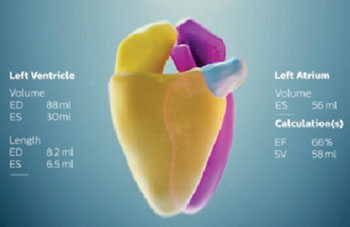Ultrasound Tools Provides Confidence in Cardiac Care
By MedImaging International staff writers
Posted on 20 Sep 2015
A new anatomically intelligent ultrasound (AIUS) tool brings advanced quantification, automated 3-D views, and robust reproducibility to echocardiology. Posted on 20 Sep 2015
The Royal Philips (Amsterdam, The Netherlands) HeartModelA.I is designed to automatically detect, segment, and quantify the left atrium (LA) and left ventricle (LV) volume and ejection fraction (EF). The model-based segmentation algorithm is based on prior knowledge of the general structural layout of the heart, how heart location varies within an image, the ways in which the heart shape varies, and the ways in which the heart is imaged using ultrasound. This prior information is what enables the HeartModelA.I. to adapt the model to hearts typically seen in a clinical scenario.

Image: Cardiac model used in the Philips HeartModelA.I (Photo courtesy of Royal Philips).
Clinically, HeartModelA.I is designed to detect two LV endocardial borders, at end-diastole (ED) and end-systole (ES). The two endocardial borders mark the inner and outer extents of the myocardial tissue at the blood-tissue interface and at the interface of the compacted myocardium. By thus segmenting the inner and outer extents of the myocardial tissue, an intermediate location can be more robustly defined across a wide range of heart shapes and image quality 3-6 times faster than current methods that are based on using 3D measurements.
When editing of the borders is necessary, the user has two editing options available - a global or regional edit. The global edit consists of adjusting the ED or ES slider value, or relative location of the single LV endocardial border relative to the inner and outer borders that were automatically detected by the algorithm. Regional editing involves adjusting the border on a more localized basis via control points placed along the contour, allows the user to use the application even on hearts exhibiting a very unique or irregular shape.
“Health systems are constantly looking for solutions to provide the most efficient and effective way to help clinicians make confident diagnosis,” said Vitor Rocha, CEO of ultrasound at Philips. “Conventional echocardiograms can be very time consuming. By combining AIUS with the power of HeartModelA.I, we’re able to deliver technology that helps simplify a complicated exam and makes it more reproducible.”
Ultrasound provides a cost-effective, robust imaging modality to measure cardiac function without radiation exposure. Typically, two dimensional (2D) echocardiographic images are used to measure LA or LV volume and EF output, but these measurements rely on making assumptions about the 3-D shape of the heart based only on what is seen in the 2-D image, an assumption that can significantly impact the measurements.
Related Links:
Royal Philips














